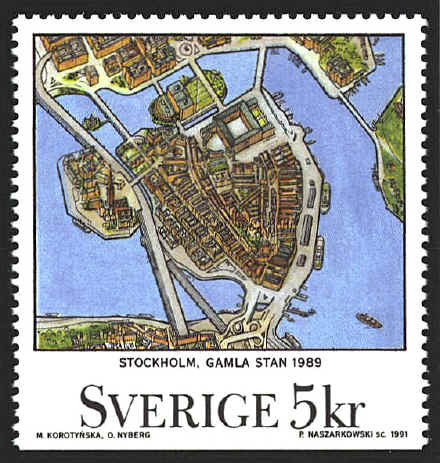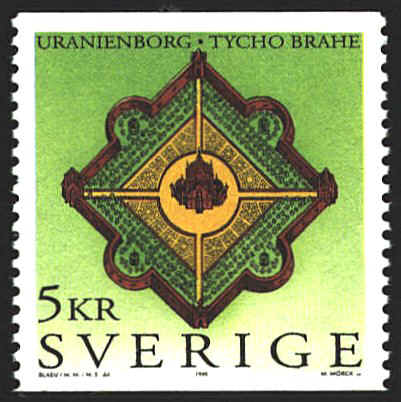|
Stockholm
Stockholm is built upon both the mainland of Upland and Södermanland,
as well as on a number of islands at the junction of Lake Mälar and an
arm of the Baltic Sea. The town was first mentioned in 1252. It was
built by the Swedish ruler, Birger Jarl, and grew rap9idly. In 1523
Stockholm was liberated from the Danes by Gustavus Vasa, and became
the capital of Sweden.
The original part of the town is Gamla Stan (Old Town),
and consists of Stads, Helgeands and Riddar islands. The Royal Palace
is located on Stads Island, as are Storkyrkan, the Church of St.
Nicholas; the German Church; the House of Lords; and a number of other
important buildings. Riddeholm Church dominates Riddar Island. And the
House of Paliament and the National Bank are on Helgeands Island.
The stamp displays a part of Gamla Stan as it was
mapped in a bird's eye view in 1989.

Uranienborg
Tycho Brahe (1546-1601)
was an Danish aristocrat. He studied at several universities, and made
observations of the weather, the positions of the planets and so on.
in 1576 Frederick II of Denmark granted him the island of Hveen
rent-free for the rest of his life, and the expenses to establish and
maintain a place where he could undertake his astronomical work. Brahe
built the Uranienborg on the island and spent the next twenty years
making naked-eye observations of the stars and planets. He made a
catalog of the positions of over 1000 stars, proved that comets were
not objects in the atmosphere, and constructed laws of planetary
motion which conflicted with both Ptolemaic and Copernican systems
The plan of the Uranienborg is based on that in Jan
Blaeu’s Geographia, quae est Blaeuianea pars prima, Amsterdam,
1662. "The grounds of Uraniborg [are] viewed from the east. The
observatory itself is at the centre, and it is surrounded by
ornamental gardens (with some 300 trees) and protected by high walls.
At the east and west corners are gates, over which are kennels for
watchdogs. At the north corner are lodgings for servants, and at the
south corner a printing office."
The Cambridge Illustrated History of Astronomy,
ed. by Michael Hoskin
Cambridge University Press, 1997, p. 104.
Brahe quarreled with the
king and left the island in 1597. The castle and the observatory
Stjärneborg were destroyed within a few years after the death of Brahe
in 1601.


 
|
